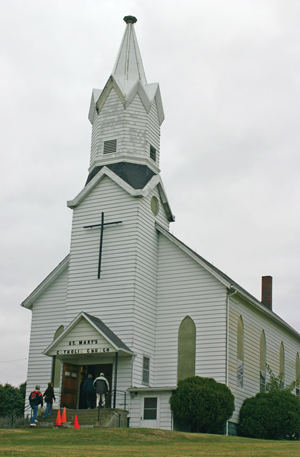By Celine Klosterman

BRYANT — They came to say goodbye.
About 75 friends of the former St. Mary Parish gathered Oct. 6 for the final Mass in the farming community of Bryant, where some of them had made their first Communion, gotten married and attended relatives’ funerals. The building at the center of those milestones — the former St. Mary Church — is slated for demolition.
Losing a church is hard, Father Scott Lemaster acknowledged in his homily. “It’s like a death,” said the pastor of parishes in Charlotte, Delmar, Petersville and Sugar Creek.
“To be a Catholic is always feast and famine, joy and sorrow.” The Virgin Mary — the former Bryant parish’s namesake — felt joy in raising Jesus and sorrow as he died, Fr. Lemaster noted. “This truth I know: Our Lady will bring joy out of sorrow. You may not see it now, but she will.”
“This is heartbreaking,” Jim Krogman said after the Mass. He joined St. Mary’s with his wife, Audrey, in 1972 after the farming family moved to the Bryant area from Maquoketa. “The church was beautiful. We were up to 60 families” before the parish was suppressed in 1993.
But Bryant lost population as agricultural practices changed, said former St. Mary parishioner Jim Determan. Now, only a handful of people farm land in the area that dozens of farmers used to tend to. A seed corn company, post office and businesses have closed. “No one works here anymore,” said Determan, who now belongs to Our Lady of Lourdes Parish in Bettendorf.
He and his sister Denise Schroeder, who also attended the final Mass, moved to a house across the street from the Bryant church as children in 1955. Lutheran since marriage, she smiled as she recalled nuns coming to St. Mary’s to teach summer catechism classes that drew children from throughout the area. Forty to 50 students attended in the 1950s, Determan said.
Schroeder now lives on a farm two-and-a-half miles from the former church, whose steeple she sees from her home. “The spiritual connection will always be here for me,” she said.
That connection still exists for Don Hughes, too. A member of Ss. Mary & Joseph Parish in Sugar Creek, he comes to Bryant twice a week to visit the Catholic cemetery where his wife, Linda, was buried 10 years ago.
“I could have shed a tear going to Communion,” he said, knowing it was the last time he’d receive the Eucharist in Bryant.
He fondly recalled hog roasts and pancake breakfasts he took part in after joining St. Mary’s in 1966. “It was fun working together on those things.”
“Everyone here knew everyone,” said Audrey Krogman, who now belongs to the Sugar Creek parish. “When one person was sad, we were all sad. When someone rejoiced, we all rejoiced. You can do that in a small parish.”
Mourning the loss of St. Mary’s, Hughes cited the Serenity Prayer: “God, grant me the serenity to accept the things I cannot change, the courage to change the things I can, and the wisdom to know the difference.”
History of St. Mary’s, Bryant
According to an account from the former St. Mary Parish, the roots of the Catholic community in Bryant extended to 1857, when Father Frederic Jean bought 40 acres of land at Nine Miles for a parish. A church was built in 1876 after being delayed by a legal error in the deed.
In 1889 the parish moved to Bryant, and a Catholic church and rectory were built.
In 1972, St. Mary’s clustered with St. Joseph Parish in Sugar Creek. In 1993, both parishes were suppressed, and Ss. Mary & Joseph Parish formed.
In 2000, Bishop William Franklin agreed to give oratory status to St. Mary’s, meaning that only funerals could take place there in addition to a yearly celebration of the patronal feast or date of parish founding. In canon law an oratory is a place, different than a parish church, which is set aside for worship by a specific group (such as a religious community) or for a particular need (such as a hospital chapel).
On Aug. 15, a decree signed by Bishop Martin Amos took effect, reducing the oratory and altar to profane use. As a result, the former St. Mary Church is no longer considered a sacred place and therefore may not be used for any liturgical worship.
The building will be torn down. A developer who purchased the property plans to turn it into a vineyard.







